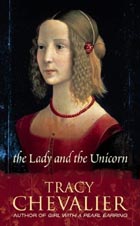The Lady and the Unicorn
The Lady and the Unicorn by Tracy Chevalier (author of Girl with a Pearl Earring) evokes in the reader a passion for tapestry where previously there was none, says Clive Aslet

The Lady and the Unicorn, by Tracy Chevalier

This is a book for anyone who does not like tapestry. I began in a state of puzzled ignorance about this beautiful but inaccessible art, and now find myself loving it. For this, I owe Tracy Chevalier my thanks.
Just as her previous success, Girl with a Pearl Earring, imagined the story behind a painting by Vermeer, so here her theme is the lovely, famous but mystifying late-15th-century Lady and Unicorn tapestries in the Musée de Cluny. We see them through the eyes of the patron, his wife, the artist, the weaving team, even their woad seller. We are shown how they reflect dynastic pride, the guild system, the special demands of the medium and, more tendentiously, certain characteristics which the author attributes to the main players, from piety to lust.
These insights hang on a story which turns on the insatiable randiness of the artist, Nicolas des Innocents. Among other seductions, he wins the heart of the patron's daughter, Claude Le Viste, and the favours of Aliènor La Chapelle. She is the weaver's daughter, blind but still able to check the quality of the tapestry by feel. Her father has decided to marry her to the woad-seller Jacques Le Boeuf, whose trade is so evil-smelling that no able-bodied girl will have him. Aliènor tends the garden which provides inspiration for the flowery mead that forms the background of the tapestry. It is in the garden-just about the only place one can get a bit of privacy in the La Chapelles' over-occupied home-that she succumbs to Nicolas, single motherhood being preferable to a highly distasteful marriage.
There are moments of poignancy in the book, but is it really credible that a young girl of noble birth would, on her second meeting with Nicolas, hide under a table and fondle his private parts? The only hint as to why Nicolas should exercise this extraordinary power over women is his one infallible chat-up line, about the story of the unicorn. Until now, I had not sensed much of an erotic charge in the Lady and the Unicorn tapestries. Now I see them differently. For all that Renaissance France sometimes seems more like Sex and the City, it is still a book which has left me wondering about the past: another reason to thank Tracy Chevalier.
Exquisite houses, the beauty of Nature, and how to get the most from your life, straight to your inbox.
Country Life is unlike any other magazine: the only glossy weekly on the newsstand and the only magazine that has been guest-edited by His Majesty The King not once, but twice. It is a celebration of modern rural life and all its diverse joys and pleasures — that was first published in Queen Victoria's Diamond Jubilee year. Our eclectic mixture of witty and informative content — from the most up-to-date property news and commentary and a coveted glimpse inside some of the UK's best houses and gardens, to gardening, the arts and interior design, written by experts in their field — still cannot be found in print or online, anywhere else.
